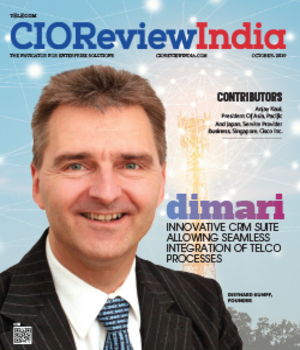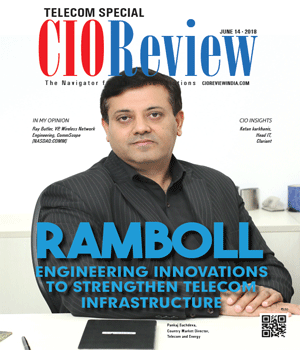
How the Advent of IoT in Telecom Will Impact the Industry
Janifha Evangeline | Sunday, 11 April 2021, 14:02 IST

The role of telecom service providers in facilitating communication between people and devices is anticipated to be transformed owing to the introduction of the Internet of Things in the telecom industry and hence, organizations not only need to devise new IoT-enabled services for their customers and applications for improving their business processes but they can also implement innovative business models such as SaaS, PaaS, and BaaS to utilize IoT effectively. By following this approach, telecom companies can easily decide what kind of applications and which applications exactly can be beneficial for their organizations.
Intending to adapt itself to the new technological and cloud trends, the telecommunication industry is going through a transformational phase of development. The advent and use of IoT in telecom companies will not only display its potential to enhance business procedures but also help in generating more revenue. Therefore, telecom companies use the IoT to deliver a collection of products and services that facilitate obtaining additional value to their existing networks.
As the telecoms built separate networks specifically for their IoT platform, the added value IoT products and services will become very useful and these IoT platforms can be used as the foundation for developers and organizations to develop their IoT products and services.
The top three challenges in the telecommunication industry are:
- The first challenge faced by telecom companies is that they have to decentralize the purchasing and decision power, not only internally but externally as well due to the essential agile reconfiguration of the cloud.
- The second challenge is the availability of various new technologies. Due to this, the variety and quality of services from telecom companies and internet service providers (ISP) are increasing, while the profit margins are decreasing and the lines between telecom companies and technology vendors are blurring. Therefore, telecom companies need to take a fresh look at the level of ICT innovation. Also, they should adapt their organization to digital transformation by creating/developing strong cross-functional interfaces and by seeking tools for maintaining organizational flexibility.
- The third and the most important challenge waiting in the wings for telecom companies and ISPs are the impacts of IoT which is leading to rapid growth in connected devices. The most challenging part of this growth is the generation of billions and trillions of new data sources. Also, it is anticipated that this growth will push the data to be handled by networks to zettabytes per year.
Top trends in the telecommunication industry are as follows:
5G networks
The telecom carriers are working on offering the 5G networks to provide faster internet. Although the technology has still not been completely defined, these telecom carriers are working with the lab and field trials in their race to stay ahead of the curve.
Secure and reliable services
The modern telecom environment provides a rich set of services, which requires reliable and secure authentication. While the number of smartphones equipped with biometric fingerprint readers is increasing, this technology is also being used by various stakeholders such as retailers, financial institutions, the government, and even schools to verify identities.
Furthermore, the biometric mechanisms that include facial and retinal recognition are some of the telecom trends that are expected to pick up steam soon. To reduce the crime rates related to mobile phones and terrorist attacks, an increasingly large number of telecom companies are adopting biometric SIM cards.
Internet of Things
Although IoT was also mentioned as part of the challenges faced by the telecom industry owing to the humongous amount of data generated by connected devices, this is also set to be one of the major trends that will facilitate in providing telecom companies with a myriad of opportunities in the coming future. The most important benefit of becoming an IoT connectivity service provider and providing M2M devices could open up new streams for Telecom companies.
Another interesting fact about IoT is that the Telecom sector ranks fourth as far as spending on the Internet of Things technology is concerned, according to a survey conducted by TCS.
While making software-based updates to their products and services has been rated as the top business process improvement by Telcos, providing better service, providing customized marketing campaigns, improving customer segmentations are the other business improvements offered by them.
Some of the Innovations in the Telecom Industry using IoT are as follows:
The dashboard of the world’s largest telecommunications company and the second largest provider of mobile telephone services facilitates simplifying the IoT implementations and this is known as “The Asset Management Operations Center (AMOC)”. What is unique and most significant about this dashboard is assets from numerous and different vendors that run various protocols can be managed effortlessly through the AMOC dashboard, and this is hosted in the Microsoft Azure cloud. Support for cellular and satellite connections, easy integration into a myriad of applications, security for sensor data and asset management, and compatibility with multiple LTE and LTE-M devices are some of the stunning features of this dashboard built using IoT.
A Dedicated IoT Network
One of the American telecommunications companies created an entirely independent network dedicated to IoT devices, which is called Curiosity IoT. Curiosity IoT consists of the Curiosity Core and Curiosity OS. While the Curiosity Core is a virtualized and distributed network core that is said to be 5G ready, the Curiosity OS offers organizations the ability to manage all connected IoT devices, speed up the development of IoT devices and time to market, automate a business process, get immediate intelligence on generated data.
Ricky Singh, head of products and solutions for Curiosity IoT at Sprint, spoke about how Sprint uses IoT devices themselves in an interview with SDxCentral. “Our supply chain team has been one of our champions inside the organization to track valued assets from where they’re shipped from the manufacturer to their forward store location, and then when they go out to their sites, they can track the USD 20000 Radiohead to ensure you know that it’s not lost.”
The future of IoT in the Telecom industry
It is advisable for telecom industries to take a more informed approach to simplify the business processes as they can help them ride the digital transformation wave, effectively. Furthermore, the cloud and subscription billing complexities can be simplified with the implementation of the right tools.
CIO Viewpoint
Big Data and the Big Opportunities
By Bipin Kumar, Head - IT & Projection at Cinèpolis India
Optimized Networks For An Agile Workplace
By Steve Miller, CIO, Steelcase
The Hidden Revenue Potential in Mobile Big Data
By Manuel Stopnicki, CTO, Tektronix Communications
CXO Insights
Unlocking Efficiency: The Future of Smart...
By Ganesh Lakshminarayanan, CEO – India, Airtel Business
Data Center Modernization: Transforming the...
By Rajesh Tapadia, COO, Nxtra by Airtel
Revamping Workflow In Pharma Industry With...




.jpg)
.jpg)




